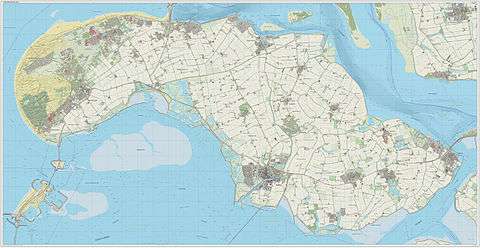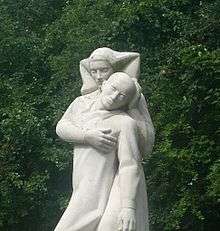Schouwen-Duiveland
| Schouwen-Duiveland | |||
|---|---|---|---|
| Municipality | |||
|
Zierikzee city centre | |||
| |||
.svg.png) Location in Zeeland | |||
| Coordinates: 51°39′N 3°55′E / 51.650°N 3.917°ECoordinates: 51°39′N 3°55′E / 51.650°N 3.917°E | |||
| Country | Netherlands | ||
| Province | Zeeland | ||
| Established | 1 January 1997[1] | ||
| Government[2] | |||
| • Body | Municipal council | ||
| • Mayor | Gerard Rabelink | ||
| Area[3] | |||
| • Total | 488.21 km2 (188.50 sq mi) | ||
| • Land | 230.07 km2 (88.83 sq mi) | ||
| • Water | 258.14 km2 (99.67 sq mi) | ||
| Elevation[4] | 0 m (0 ft) | ||
| Population (May 2014)[5] | |||
| • Total | 33,833 | ||
| • Density | 147/km2 (380/sq mi) | ||
| Time zone | CET (UTC+1) | ||
| • Summer (DST) | CEST (UTC+2) | ||
| Postcode | 4300–4329 | ||
| Area code | 0111 | ||
| Website |
schouwen-duiveland | ||
Schouwen-Duiveland (Dutch pronunciation: [ˈsxʌuə(n)ˈdœyvəlɑnt]) is a municipality and an island in the southwestern Netherlands province of Zeeland. The municipality has 33 737 inhabitants (January 1, 2016) and covers an area of 488.94 square kilometres (188.78 square miles) (of which 257.87 square kilometres (99.56 square miles) is water).
The island has two fixed connections to Goeree-Overflakkee , the Brouwersdam and the Grevelingen . The Oosterschelde is like the Zeeland bridge to North Beveland . The island is mostly flat and parts are below the sea level. On the western tip is a dune whose highest point is about 42 meters above sea level. The island is, in the summer, very popular with (German) tourists. The Renesse area is a popular holiday destination for young people.
The Brouwersdam is a dam, part of the Delta Works, from Schouwen-Duiveland to Goedereede, the west part of the island of Goeree-Overflakkee in South Holland.
History
The island of Schouwen-Duiveland was originally four islands: Schouwen, Duiveland, Dreischor and Bommenede . Over the centuries it has grown by nature and man together. The dam between Schouwen and Duiveland dates from 1610.
On April 30, 1900 the Rotterdam Tramway Company opened a steam tram line on the island running as public transport until 1 February 1953. After the floods of 1953, the service has not been restored and has been replaced by a bus line.
During the Second World War, it was the only island that remained under German occupation until May 1945 was Schouwen-Duiveland. In December 1944, the Germans had declared their intent to deport all local men aged between 17 and 40. The local resistance fighters made plans to sabotage this by stealing all the registers on the island with the help of nearby Allies, who were preparing to liberate the island. Events unfolded that led to the capture of ten local men who were subsequently executed.[6]
After the completion of the Brouwersdam in 1972 the island became a center of water sports. Surfing, sailing and diving are common activities on the North Sea beaches and the Grevelingenmeer.
Geography
Topography

Dutch Topographic map of the island of Schouwen-Duiveland, as per Sept. 2014.
Demography
The main population centres are listed in the tables below (as of January 1, 2014).
|
|
There are two places in Schouwen-Duiveland, Zierikzee and Brouwershaven, which in the past had gained city rights. Then there are the hamlets Looperskapelle, Moriaanshoofd, Nieuwerkerk, Nieuwerkerke, Schuddebeurs, Westenschouwen, Zierikzee, Beldert , Brijdorpe , Burghsluis, Capelle , Elkerzee and New Haamstede. The town hall is in Zierikzee.
There is no village called Schouwen-Duiveland; the municipality takes its name from the island, which received its name when the former islands Schouwen and Duiveland (and Dreischor) were poldered together.
Governance
_(14322773565).jpg)
The municipality of Schouwen-Duiveland on 1 January 1997 came about after six municipalities were merged. These municipalities were Brouwershaven , Bruinisse , Duiveland , Middenschouwen , Westerschouwen and Zierikzee . These six municipalities were created on January 1, 1961 from a previous reclassification.
City Council
The council of Schouwen-Duiveland consists of 23 seats. Below is the composition of the council since 1997:
| Partij | 1997¹ | 2002 | 2006 | 2010 | 2014 |
|---|---|---|---|---|---|
| Leefbaar Schouwen-Duiveland | - | 4 | 3 | 4 | 5 |
| VVD | 7 | 4 | 4 | 5 | 4 |
| CDA | 4 | 4 | 4 | 3 | 3 |
| SGP | 3 | 2 | 2 | 3 | 3 |
| SP | - | - | - | - | 2 |
| PvdA | 4 | 3 | 5 | 2 | 2 |
| ChristenUnie | 2 | 2 | 2 | 2 | 2 |
| D66 | 2 | - | - | 1 | 1 |
| Independent Schouwen-Duiveland | - | 3 | 2 | 2 ² | 1 |
| GroenLinks | 1 | 1 | 1 | 1 | - |
| Total | 23 | 23 | 23 | 23 | 23 |
November 13, 1996 ¹ reclassification elections were held. The first council was launched on January 1, 1997.
Mayor & Aldermen
- Mayor Gerard Rabelink (None)
- Councillor Jacqueline Burg ( Liveable Schouwen-Duiveland )
- Alderman Ad Verseput ( VVD )
- Alderman Cees van den Bos ( SGP )
- Secretary Marieke van den Heuvel
Culture

There are a number of national monuments in the municipality, including the war memorial at Oude Moolweg in Renesse and the Jewish Memorial on Caustraat in Zierikzee. The war memorial commemorates, in particular the ten local resistance fighters executed by the Germans on 10 December 1944. It also commemorates all local citizens who died during the Second World War or the police actions in the Dutch East Indies.[6]
The Westenschouwen mermaid was the main character in a saga that is localized in Zeeland relating to the destruction of the village Westenschouwen on the island of Schouwen-Duiveland . The mermaid saga explains the decline of this once prosperous village. The saga predicts the end of the village and only the tower would remain. After the tower was demolished in 1845, the Plompe Tower was seen as the remaining tower of Westenschouwen. Plompe tower is open to tourists and when you open the door of the tower the story of the mermaid will be played automatically and displayed via a carousel stories. The mermaid is celebrated in the local coat of arms.[7][8][9]
Notable residents
- Jan van den Bosch - TV presenter on RTL5
- Leen van Dijke (b. 1955) - member of the Reformatory Political Federation (Reformatorische Politieke Federatie) and its successor the Christian Union (Christen Unie), he was a member of the Dutch House of Representatives from 1994 to 2003 as well as Parliamentary leader from 1994 to 2002. He was also a member of the provincial parliament of the province of Zeeland from 1987 to 1994.
- George van Heukelom (politician) - is a Dutch former politician for the Reformed Political Party (SGP).
- Nelli Cooman (b. 1964) - 60 metres two-time World indoor champion, six-time European indoor champion and former world record holder and since 1991 lives in Nieuwerkerk .
References
- ↑ "Gemeentelijke indeling op 1 januari 1997" [Municipal divisions on 1 January 1997]. cbs.nl (in Dutch). CBS. Retrieved 13 December 2013.
- ↑ "Portefeuilleverdeling" [Tasks] (in Dutch). Gemeente Schouwen-Duiveland. Retrieved 13 December 2013.
- ↑ "Kerncijfers wijken en buurten" [Key figures for neighbourhoods]. CBS Statline (in Dutch). CBS. 2 July 2013. Retrieved 12 March 2014.
- ↑ "Postcodetool for 4301SH". Actueel Hoogtebestand Nederland (in Dutch). Het Waterschapshuis. Retrieved 13 December 2013.
- ↑ "Bevolkingsontwikkeling; regio per maand" [Population growth; regions per month]. CBS Statline (in Dutch). CBS. 26 June 2014. Retrieved 24 July 2014.
- 1 2 "Renesse War memorial (website in Dutch)". Retrieved 30 March 2016.
- ↑ "Plompe Tower". Retrieved 30 March 2016.
- ↑ Bert. A. Oosterhout (1998). Sprookjes uit de wereldliteratuur; Nederlandse & Vlaamse sprookjes. ISBN 90-389-0813-X.
- ↑ Anton Pieck, Alet Schouwen (1989). Volksverhalen der Lage Landen. ISBN 90-269-4057-2.
External links
| Wikivoyage has a travel guide for Schouwen-Duiveland. |
| Wikimedia Commons has media related to Schouwen-Duiveland. |
- Official website (in Dutch)
 |
Goeree-Overflakkee (ZH) Grevelingen |
 | ||
| North Sea | |
|||
| ||||
| | ||||
| Oosterschelde Noord-Beveland |
Keeten-Mastgat / Tholen |



